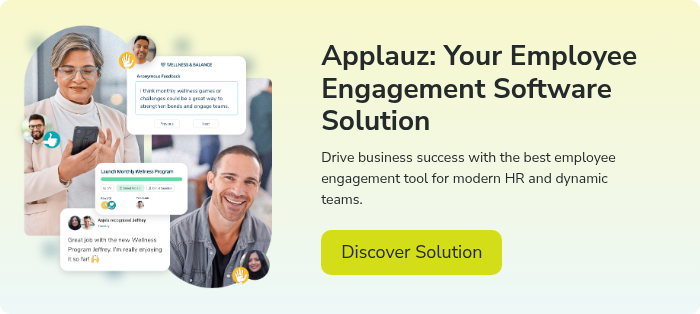Employees come and go - but how often do you think about the “stayers?”
The unsung heroes who opt for continuity within your workforce, those whose enduring presence forms the very foundation of your organizational strength — the 'stayers' — tenured employees, often get overlooked by leadership, as attention tends to sway more towards recruiting top-tier talent or dissecting the departure of other team members.
Yet, the tide is turning, sparked primarily by the Great Resignation of 2021, compelling companies to launch wide-scale initiatives to retain their best and brightest. These efforts are particularly important when the cost of employee turnover is considered. According to Gallup, the costs of replacing a single worker can range from half to four times the employee's annual salary.
That’s when the Stay Interview comes in. It isn’t a mere interview; - it’s a personal one-on-one conversation held with current employees giving them the chance to provide honest feedback about what motivates them to stick around, what could be better about their work experience, and how they envision the next stage of their career within your organization.
The art and science of employee retention has long been a challenge for many businesses.
The reality is that compensation and benefits only serve as the baseline when it comes to retention; crafting "sticky" environments involves actively listening to employees, addressing their concerns, fostering a sense of safety and community, and measuring the impact. Are you genuinely tapping into the insights of those in crucial roles? What does your everyday work look like from their perspective? Are you delivering meaningful interactions, rather than just rote transactions that only make them feel more withdrawn and burnt out?
Admittedly, it’s not easy for a leader to determine when and how to engage individually with their employees. However, companies that don’t invest in such conversations—perceiving stay interviews and other one-on-one interactions as a burden, holding them too inconsistently, or managing them poorly— jeopardize the connection of their team members and employee retention rates in more than a few ways.
Stay interviews are just one of the instruments you have at your disposal to better understand your team and take the relevant actions to provide the sense of unity and purpose that they crave.
Stay Interviews Explained

Stay interviews, also referred to as retention interviews in many cases, take the form of personal one-on-one discussions with current employees to explore why they appreciate working at your company and identify potential improvements in the business, team, or role.
These conversations not only gauge an individual's flight risk level but also assist your business in anticipating hiring needs and kickstarting succession planning.
Unlike exit interviews, where HR teams typically lead discussions with departing employees, stay interviews are primarily driven by the individual's direct manager or skip-level manager. This distinction arises from the specific goals of each conversation.
While exit interviews seek to uncover underlying issues that might contribute to employee departures, effective stay interviews focus on gathering insights to enhance the experience for a particular individual. Given that managers wield significant influence over an individual's day-to-day experience within your company, it's only natural for them to take a more prominent role in these personalized employee retention conversations.
Keep in mind that the exact purpose of a stay interview may vary between organizations. Still, the majority are employee engagement check-ins that help you understand specifics on why your employees have stayed at the organization and what has the potential to cause them to leave.
Besides, it’s an excellent opportunity to gather employee feedback and delve deeper into the personal side of an employee, not just their current work. You want to know about their aspirations, their dream job, what inspires them, what they look for in a leader, as well as what kind of passions they want to nurture outside of work or self-development. This provides you with a starting point on how you can support the whole person — not just the professional persona.
The State of Employee Retention

The term may have been coined in 2021, but the Great Resignation is still ongoing.
According to the Bureau of Labor Statistics, the average turnover rate across the US in 2023 is around 3.8%. Nearly two-thirds of those turnovers are attributed to quitting employees.
The same study concluded that the average tenure of an employee stands at 4.1 years, with younger employees demonstrating more of an inclination to change jobs more frequently.
The most concerning aspect is the cost of employee turnover and what it takes to replace candidates. A Monster study said that replacing an employee costs between 75% and 200% of the worker’s annual pay.
Clearly, there is cause for HR departments to be scrambling for new recruiting frameworks. However, most experienced leaders know that it’s not just recruitment that needs an overhaul; it’s retention. Most employees would prefer to stay on board if they’re supported by management; they actually have a 20% chance of working at their current company in a year if they feel stable enough.
In the past, surges in voluntary quitting often indicated a talent competition, where sought-after professionals transitioned from one job to a comparable but more favorable position in another company. However, this latest wave of “resignations” distinguishes itself, as many people are leaving to embrace entirely different roles or opting to say goodbye to the industry or workplace altogether. You have to contend with the entire spectrum of work experiences available to today's workforce, including both traditional and nontraditional roles and, in some cases, no employment at all.
Retention strategies aren’t a cookie-cutter concept, and their effectiveness varies across industries, locations, and organizations. What may be a straightforward solution for other businesses might not apply to you at all. Nonetheless, there are overarching reasons why certain employees might be pondering their exit as you read this.
Recent research from McKinsey validates that the primary two reasons employees mentioned for leaving (or thinking about leaving ) were a sense of undervaluation of their work by the organization (54%) and a lack of belonging in the workplace (51%).
With that in mind, how do you redefine your attraction and retention strategies and create a value proposition that considers employees' entire lives? How do you cultivate a purposeful company culture that enables meaningful and valuable feedback, allowing you to genuinely inquire about your team's progress, with their professional or personal aspirations?
Stay interviews won't single-handedly activate purpose in your employees' work lives, but they can serve as a channel through which you can acknowledge your team members for their continued loyalty and hard work and improve employee satisfaction. Use this moment to candidly explore their obstacles, needs, requirements, and perspectives.
When you ask team members for their input, you provide them with a sense of empowerment and confidence that makes them feel valued. You want them to be brimming with a sense of belonging by the end, and it's challenging to leave places where you belong.
 The Benefits of Conducting Stay Interviews
The Benefits of Conducting Stay Interviews
There are a wealth of benefits when it comes to conducting stay interviews. Not only do they give an employer time to rectify a situation before losing a quality employee, but they also make employees feel like they matter.
Not to mention, as your team members build a lasting connection with the company, they naturally become well-versed in your processes and objectives, resulting in measurable gains in efficiency and productivity. Your experienced staff directly contributes to a positive work atmosphere, elevating morale and fueling teamwork and collaboration. This enduring stability not only lessens the financial strain linked to constant recruitment but also lays the groundwork for your team's overall performance, fostering lasting prosperity and growth for your business.
Retaining top talent
One of the most effective use cases of stay interviews is targeting your most valuable, top-performing employees, identifying how to keep them happy, and then taking action to fulfill their needs, improving the likelihood that they will stay with your business for longer. Take a moment to appreciate their contributions — you can even consider tools that celebrate, reward, and motivate your workforce in a personalized fashion.
While most stay interview findings will most immediately impact your ability to make one individual happy, such as giving one employee new responsibilities or stretching projects in their interest areas, some topics of discussion that pop up in these conversations can help you improve the employee experience for all your workers. For example, realizing you need to offer more professional growth opportunities or secure additional headcount to improve work-life balance for the team. Stay interviews are just one way to listen to your employees, but it’s helpful to also regularly survey your teams to understand how morale is changing and identify areas where your business can improve.
Read More: Proven Employee Retention Tools & Strategies To Bolster Your Workforce
Improving employee engagement and productivity
As per the Harvard Business Review, individuals who receive minimal or no interaction with their manager tend to exhibit higher disengagement levels. On the other hand, those who enjoy twice the number of personalized sessions with their manager compared to their colleagues are 67% less likely to experience disengagement.
After all, these discussions provide a platform for acknowledging employees' contributions, addressing their needs, and understanding their perspectives. As opposed to a performance review, you’re asking strategic questions such as: Are we focused on the right things? Are you satisfied with your work environment? Your goal is to show your commitment to helping your colleague develop and grow but also to step back, remember the organizational mandate, and think about how best you can work side-by-side with this person to get things done. When each employee has the chance to ask their manager for information on where the organization is headed and how their work fits into the bigger picture, they’re much more invested in your organization's success.
Retention and productivity go hand in hand with how involved and committed your team feels.
Identifying and addressing employee concerns
Employees who feel heard are 4.6 times more likely to perform their best work. Despite the mutual desire for richer communication in the supervisor-employee relationship, it often falls short due to fears of repercussions or skepticism about the actionable impact of discussed feedback.
A successful stay interview aims to cultivate an environment based on honesty, support, and trust, building a culture of trust and providing a safe space for employees to share input freely. Simply granting "permission" for negative feedback isn't sufficient; managers must explicitly convey their preference for constructive feedback. This approach helps alleviate any reluctance or apprehension on the part of employees.
Trust begins to blossom when there's transparency, where leaders admit their shortcomings or openly share when a solution isn't immediately available. While a stay interview may not necessarily change your employees’ minds if they do want to leave in the foreseeable future, taking that extra step to find answers or collaborating with employees on solutions completes a loop, demonstrating that your leadership is truly supportive.
Building a positive organizational culture
It’s easy for things to go unnoticed.
If an employee is having a bad day or week or is unhappy in their role, or if just about anything else is wrong in their eyes, it’s easy to hide it.
Cultures where important things get left unsaid are unproductive, unpleasant, and toxic to the business.
And without any encouragement or processes for pulling those important things out of people, you might be in danger of building that kind of culture.
Beyond the ordinary check-ins, stay interviews carve out a space for transparent communication, nurturing a feeling of belonging and dedication. It's a time for team members to express dreams and concerns, confident that their opinions are heard. Through these discussions, trust flourishes, and connections fortify, adding to a constructive work ambiance. The deliberate act of actively seeking input from employees during stay interviews conveys a potent message — your organization is deeply invested in its workforce. It transcends a mere retention tactic; it's a declaration of a culture that values open dialogue, perpetual growth, and the collective evolution of both individuals and the entire company.
 Best Practices for Conducting Stay Interviews
Best Practices for Conducting Stay Interviews
Stay interviews and other 1-1 meetings often feel more hurried and disorganized than they need to be. Keeping a regular check on each employee is essential, but how can you make the most of these moments? How do you turn these meetings into productive and collaborative exchanges? Consider the changes you, as a manager, need to make and the modifications you might encourage your direct reports to adopt.
Creating a safe and open environment
The space you create for your employees sets the stage for the caliber of the conversation.
Employees need to know there are mechanisms in place for them to share their thoughts about why your company is a great place to work and also where you could improve. Ask if there’s anything else to add before you dig in. If you anticipate that there are hard things to discuss, try to bookend it with two positive topics. Given that the purpose of the stay interview is to inspire confidence about the employee’s future in your organization, go the extra mile to ensure the close of the meeting doesn’t leave your employees feeling down.
Establishing a shared collaborative space for upcoming discussions is a great way for managers and employees to prepare thoroughly, strengthening the conversations as well as their outcomes. Using open-ended questions promotes meaningful discussions, and it's important to avoid dominating the conversation. Provide space for each person to share, pause for discussion, and encourage questions.
To help keep it informal, you could go on a walking meeting, have a coffee, or meet for breakfast — just remember to take your discussion points with you. This might be helpful when discussing topics like constructive feedback or professional goals.
Ensure the timeliness of the interview
The frequency with which you have stay interviews will vary depending on the size of your team, how big or small your organization is, how high-maintenance or experienced your employees are, and where you sit in the org chart. It doesn’t necessarily matter how often they take place, but it is paramount that you schedule them on your calendar as a repeating event.
This will pave the way for a smooth, effortless conversation — when employees know they have a standing meeting, they are less likely to barrage you with a “constant stream of interruptions.” If you’re new to the fold of stay interviews, you may want to consider experimenting with frequency until you find the right rhythm.
Other points to note would be showing up on time, not canceling at the last minute, and crafting a manageable agenda. You can even summarize the agenda at the outset of the conversation but be open to changes.
Address challenges & skepticism
Stay interviews provide an opportunity to invest in building trust and demonstrating your commitment to your employees.
Employees may feel more inclined to share their concerns openly when it's done in a confidential setting, giving them peace of mind that their feedback won't lead to any repercussions. This way, you can zero in on some of the issues that may have otherwise gone unnoticed and even nudge them in the right direction on how to fix them.
They also appreciate the safety of confidentiality because it gives them a chance to share meaningful information and express feelings they've always had but didn't know how to communicate. The result is greater cohesion within your businesses, reduced employee turnover, and better teamwork.
Sometimes it’s helpful to share some personal anecdotes or experiences in the context of the stay interview. And, in the interest of transparency, try to share as much as you can about the current health and future goals of the company. Although there might be some details that can't be disclosed, disseminating critical information about the company’s growth trajectory and its vision for the workforce shows that you trust your employees, which, in turn, helps them have greater faith in you.
Involving the right stakeholders
You want a wide range of stakeholders to be invested in listening closely to employee goals and preferences, including managers, HR professionals, and relevant team leaders.
Not only does this bring diverse perspectives to the table, but employees also know that those who have had a significant impact on your company’s growth demonstrably care about their presence. It shows that the organization is willing to rally key individuals to identify issues and promote a collective commitment to improving the work environment.
Training interviewers and managers
Leading and guiding a stay interview can be surprisingly difficult, especially if the stakeholders involved haven't navigated one before.
Training interviewers and managers for stay interviews go a long way in transforming these conversations into safe spaces. While this transformation should begin at an organizational level, leaders can also focus on building psychological safety and trust in their relationships with employees. They can begin by being transparent, practicing active listening, and making it clear that the intention is always to support the employee, not to fault them. Targeted training not only transforms communication but also cultivates a sense of trust and openness. It allows managers to connect with employees on a personal level, showing genuine care for their well-being and professional growth.
Utilizing technology for stay interview programs
While it's essential to confirm that the stay interview process remains authentic, fostering open conversations on an equal footing with employees, it's worth noting that numerous platforms in the market can significantly automate various other facets of employee engagement and recognition.
For example, Applauz stands out in maximizing employee engagement by providing a comprehensive that goes beyond traditional recognition. You can find tools for cultivating company values, staying connected through a centralized hub, and appreciating individual and team efforts through recognition systems. There are features that inspire and motivate employees to reach new heights personally and professionally, fostering an aspirational environment.
Building a follow-up plan
The only way a stay interview can be effective is if the employee feedback is taken seriously and used to affect change. Otherwise, it becomes another meaningless, menial task. Likewise, employees will notice nothing is being done with their feedback and stop speaking up - posing a potential risk of them deciding to leave sooner rather than later. You want to understand what it is about the company that makes people want to stay and what gives you a competitive advantage.
Tools like Applauz make it easier than ever to tap into real-time, unbiased insights into your team and culture all year round. You can strategically dive into actionable analytics that seamlessly links every aspect of your employee engagement program, providing you with a holistic overview.
The information obtained from each stay interview should be documented and shared with anyone who makes decisions in the company such as executives, management, leadership, and HR. These decision-makers should prioritize coming together to review the feedback, identify patterns, prioritize opportunities for improvement, and evaluate what action steps need to be implemented.
 10 Essential Stay Interview Questions
10 Essential Stay Interview Questions
If you're all set to dive into the stay interview and have put together a thoughtful agenda, let's get the conversation flowing with some questions.
Though you should make sure the questions align with both your organizational vision and the unique qualities of the employee, it’s recommended to bring a couple of standard templates to the table to kick off the discussion on a positive note.
Here are some examples of stay interview questions to encourage your team members to openly share their motivations and commitment to staying with the company:
-
How would you like to be recognized?
In a nutshell, when your company excels at making individuals feel appreciated and acknowledging their contributions, it significantly boosts their engagement and productivity.
On the other hand, a dearth of recognition may drive individuals to seek opportunities elsewhere — underscoring the importance of including such a question in your lineup of stay interview queries.
-
Do you feel we provide professional growth opportunities in the areas you want to grow?
This question taps into the heart of an employee's ambitions, fostering a personal connection quite immediately, as it empowers them to voice their desires for growth. Addressing their aspirations not only enables them to see their work through a different lens but also strengthens the employer-employee relationship.
-
What is the most exciting part of your job?
Digging into what truly excites an employee about their role provides valuable insights into their passion and level of engagement. Armed with this understanding, you can tailor efforts to not only boost job satisfaction but also capitalize and build upon their enthusiasm for even greater workplace success.
-
What do you think about before work every day?
Getting a sense of what's on an employee's mind before they start their shift offers a window into their motivations, concerns, or aspirations. Only after you gauge their overall job satisfaction can you design a work experience that aligns with their needs and aspirations.
-
What are we currently not doing as a company that you feel we should be doing?
Not only does this question encourage employees to openly share their perspectives on areas where the company can improve, highlighting potential blind spots, but it's also vulnerable, seeking honesty and constructive criticism. Acknowledging possible gaps or unmet needs creates an environment where employees feel valued and heard. This vulnerability not only fosters trust but also swings open the door for positive change.
-
What one thing that if changed in your current role, would make you consider moving on?
By honing in on one aspect that could potentially influence your employee’s decision to stay or go, this question goes beyond general feedback.
Think of it as shedding light on specific areas to improve your employee's work experience. This model allows you to pinpoint exactly where adjustments are needed before issues arise — ensuring everyone's happiness, teamwork, and satisfaction, or at least to the best of your abilities.
-
What would you like to see me, as your organizational leader, do more or less of?
You often hear that employees don't quit jobs; they quit managers. Embracing constructive criticism can be a game-changer for your leadership skills. For instance, if you discover the need for more frequent feedback, try weekly or biweekly one-on-one sessions. The key is to gather valuable, actionable insights—even if they're not all sunshine. If your rapport with a team member is strained, HR could provide a more comfortable space for honest answers.
-
What do you like most about your job and why?
As opposed to asking about the most exciting part of their job, this question invites a broader, contemplative response — opening the door for a more comprehensive exploration on the employee’s part.
You want to understand the types of projects and responsibilities your employees enjoy. People usually prefer the tasks they are best at, so it can also help you determine their strengths. An additional moment of reflection, especially towards the end of the interview, can reinforce why they want to continue staying in your organization. If you remind them of what gives them purpose in their day-to-day, as well as the emotional and intellectual value that your opportunity provides to them, you're likely to increase employee engagement, which can boost retention and performance for your entire team.
-
If you were a manager for a day, what would you change?
This question adds a fun twist by letting your team imagine being a manager for a day and envisioning a dream organization. It's a unique way to uncover what improvements they'd prioritize, from the obvious like salary to those subtle changes often missed. For the trickier issues, it encourages open discussions about the challenges. On the doable side, it invites them to share their vision for implementing positive changes. Just think of the impact when your team sees their ideas turn into real organizational improvements. It's like giving them a chance to shape a workplace they'd truly love.
-
Jump ahead in your career for three to five years. Where do you see yourself?
You are likely to lose top talent if you don’t have a clear career advancement path for each employee. Your team members will think they need to leave to get a higher title and salary, even if you’re willing to prepare them for new responsibilities and an eventual promotion.
Answers to stay interview questions like this will help you set up and clearly articulate a career development plan for your employees so they know the goals and skills they need to get a raise and promotion. This will have the added benefit of increasing employee morale, engagement, and retention, not to mention recruitment.
 Fueling Your Work Culture Through Engagement
Fueling Your Work Culture Through Engagement
In today's battleground for talent, regular touchpoints like stay interviews demonstrate a real commitment to professional development and unlock each person's potential. Thoughtfully implemented stay interviews can allow you to know your team deeply as individuals and optimize their engagement and growth.
Managers should spend just as much time understanding why employees choose to stay as they would scrutinizing turnover rates. Clearly, your organization is doing something right with those employees, so how can you operationalize and apply it to the larger workforce spanning multiple roles and departments? Moreover, based on the insights gleaned from stay interviews, how should you adjust hiring strategies to ensure recruiting "stayers"?
Everyone desires stability and reassurance in a workplace where each team member feels seen, heard, connected, and productive. While some may consider it an overly idealistic dream, you have to initiate the journey somewhere. At the very least, stay interviews create a pathway to understanding your team personally, offering a glimpse behind the curtains and insights into their values for working.
As managers, your initial efforts to provide these benefits to your employees may fail. Some leaders make the mistake of pressuring them instead of reassuring them. By spending time conducting stay interviews, you strengthen your skills as managers and the desire of your employees to continue working with you.
If you can concentrate on understanding why employees stay, then you can act to reinforce the right reasons and stop reinforcing the wrong ones. In other words, take a positive approach to managing retention, which will be more effective over the long run than the ordinary, negative approach of simply reducing turnover.
Shaping a positive working environment requires you to present an inspiring vision and desire —across the organization —for collective change that benefits the individual as much as it does the employer.
Designed for precisely this purpose, Applauz’s platform empowers HR professionals to strengthen organizational culture through authentic recognition, data-driven strategies employing pulse surveys, inspiring employee goals, and a rewards system that goes beyond mere acknowledgment to offer tangible incentives. Applauz and its comprehensive toolkit can seamlessly integrate across all organizational tiers, providing your leadership with tangible insights into Net Promoter Scores, assisting in evaluating and fostering team performance, and enabling your team members to stay connected and appreciated for their contributions.
If you want to transform the way you engage your team today and design a more vibrant and productive work milieu, schedule a demo and see for yourself how quick and effective it is to retain your best talents.
Frequently Asked Questions
What are stay interviews?
Stay interviews are one-on-one conversations between a manager and an employee, aimed at understanding the factors that keep the employee motivated and engaged at work. Unlike exit interviews, stay interviews are proactive discussions that occur while the employee is still actively engaged with the company. They focus on job satisfaction, employee development, and the overall employee engagement strategy, offering insights that can guide improvements and foster a more positive workplace environment.
How do stay interviews differ from employee surveys or employee engagement surveys?
While employee surveys and employee engagement surveys collect data from a broad group of employees at once, often anonymously, stay interviews are personal, direct conversations with individual employees. This format allows for deeper, more nuanced insights into an employee's experiences, aspirations, and concerns. Stay interviews complement the quantitative data gathered from surveys by adding qualitative depth, enabling a more comprehensive understanding of employee engagement.
Can stay interviews actually improve job satisfaction and employee engagement?
Absolutely. Stay interviews provide employees with a platform to express their needs, desires, and concerns openly. When management listens and acts on this feedback, it demonstrates a commitment to employee development and well-being. This, in turn, can boost job satisfaction and solidify an employee's engagement with the company. Stay interviews are a crucial tool in an effective employee engagement strategy, as they address issues before they lead to dissatisfaction or turnover.
Are there interview templates available for conducting stay interviews?
Yes. Aside from our guide in this article, there are interview templates designed specifically for stay interviews. These templates provide a structured approach to conversations with employees, ensuring that key topics such as job satisfaction, career aspirations, and potential areas for improvement are covered. Utilizing a template can help managers conduct effective and consistent stay interviews, ensuring that all relevant aspects of the employee's experience are explored.
How often should stay interviews be conducted to be effective?
The frequency of stay interviews can vary depending on the organization's size, culture, and specific needs. However, it's generally recommended to conduct them at least once a year. Regular check-ins allow for timely identification and resolution of potential issues, contributing to ongoing employee development and engagement. Some companies may find value in conducting these interviews more frequently, such as semi-annually, to stay closely connected with their team's evolving needs and expectations.
Who should conduct the stay interviews within an organization?
Ideally, stay interviews should be conducted by the employee's direct manager, as they are most familiar with the employee's work and contributions. This fosters a sense of personal attention and shows that the company values the individual's feedback and development. However, in cases where there might be concerns about bias or discomfort, a neutral party from HR or another manager can conduct the interview to ensure open and honest communication.
How should feedback from stay interviews be handled?
Feedback from stay interviews should be treated with confidentiality and respect. It's important to analyze the feedback for patterns and insights that could inform broader employee engagement strategies. Actionable steps should then be developed to address the concerns and aspirations mentioned during the interviews. Following up with employees about the actions taken in response to their feedback is crucial to show that their input is valued and has a real impact on the organization.
About the author
Shaoni Das
Shaoni Das is a freelance writer with expertise in HR, People, Culture, Recruitment, and Technology, and has created content for Flawless Inbound, Revenue Accelerator, Workstaff, and Applauz.





